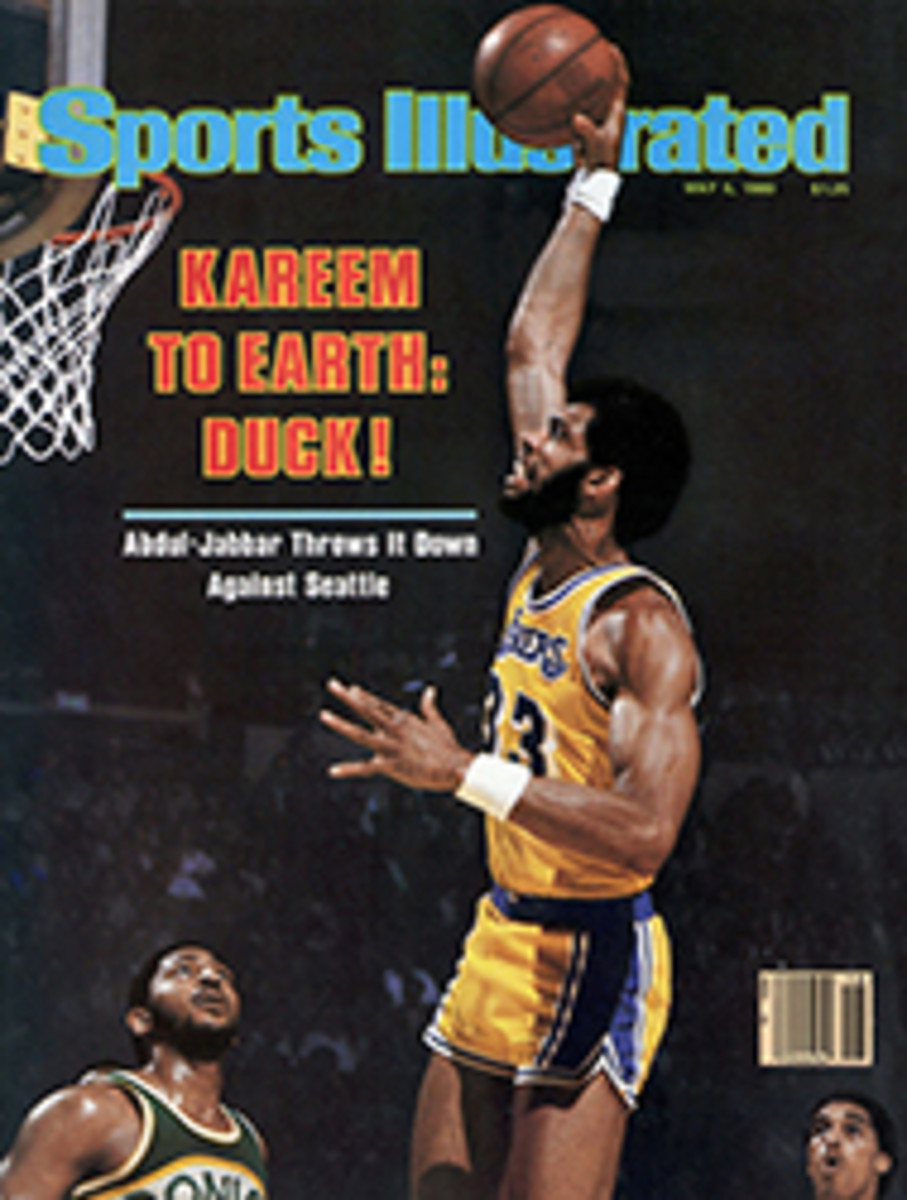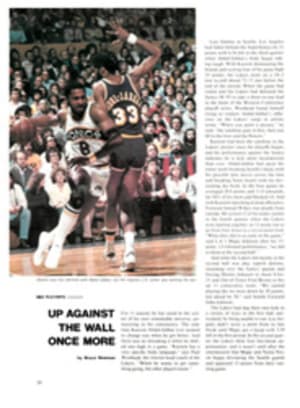
The home court advantage
Between banners of blue and white silk they gathered last week in Baltimore, the best Grand Prix riders in the world, amateur and professional, to compete head to head for only the second time. And it proved worth that city's efforts to stage the new Fèdèration Équestre Internationale World Cup as Conrad Homfeld and Melanie Smith, Americans both, took first and second against the traditionally stronger Europeans.
Until last year the expense of transporting great numbers of riders and their horses from one continent to another had seemed prohibitive. A few Americans made it to Europe each year to compete in a few events, and some Europeans came here, but an international meet of any real scope had been out of the question until Max le Magnifique applied himself to the problem. Max is Max Ammann, a 41-year-old former political correspondent from Bern, Switzerland, who as a hobby used to write about jumping competitions. He had studied the sport well and could tell you, for instance, that the first recorded jumping contest was held in 1864 as part of an agricultural show in Dublin, and that it included a "high leap" and a "long leap."
More to the immediate point, in 1978 Ammann hammered out the details of a proposed World Cup with the president of the FEI, Britain's Prince Philip. He also rounded up the money. The first Cup, in Göteborg, Sweden, was underwritten by Volvo, which now sponsors the competition to the tune of $300,000 annually. This year the Dutch Ministry of Agriculture matched Volvo's contribution, and, a nice touch, provided sterling silver tulips for the winners of seven of the 11 European qualifying competitions.
In the U.S., sports agent-impresario Mark McCormick's international management group got into the act, soliciting sponsors such as Carte Blanche ($450,000 for two years), Würzburger beer and Mercedes-Benz. It cost some $600,000 to put on the event in Baltimore and treat the Europeans in the style to which they are accustomed—free transportation for man and mount, free hotel rooms and stabling, and free hay, at least for the horses. American riders usually pay their own expenses.
The European contingent in Baltimore was led by Britain's 40-year-old David Broome, a Welshman, whom many consider the best show jumper in the world. He had led on the European circuit from the start, winning four events and amassing 54 points, 17 more than Hugo Simon of Austria, the defending Cup champion. Broome has been one of the world's most active trophy collectors for the past 25 years, with individual bronze medals from the 1960 and '68 Olympics and individual golds from one World and three European championships. A professional since 1974, Broome earns about $200,000 a year in appearance fees and prize money.
The top performer in the North American league, with 42 points after the eight American qualifying events, was Bernie Traurig, a 35-year-old from Hartland, Wis. who rides jumpers for Mr. and Mrs. William Van Dyke of Milwaukee. Van Dyke, a vice-president of an investment corporation, owns a string of notable horses that includes The Cardinal, Traurig's favored mount between 1975 and '79, and Eaden Vale, the 9-year-old chestnut gelding on which he won two World Cup qualifications this season.
Last week's World Cup finals consisted of three events on three days, with all competitors starting with zero points. In the first two competitions, points were awarded to the top 16 finishers on a scale from 20 to one. In the last event on Sunday, the spread ranged from 30 for first to 1½ for 16th place. Prize money, supplied by Carte Blanche, amounted to $14,000 for each of the first two competitions, with $4,200 going to the winner, and twice that on the final day. It is customary for prize money to be paid to amateur riders, who, officially, turn their earnings over to the horse owners.
Broome and Traurig had to be considered the co-favorites, but in Grand Prix jumping even the most knowledgeable aficionado doesn't dare predict a winner. One fault—a rail kicked off the top of a fence by a hoof, one block nudged from a 5'6" wall, a landing inches short of clearance of a water jump—will almost certainly ruin a rider's chances. So it was for both Broome and Traurig. Broome's Queensway Sportsman, a 15-year-old bay gelding, kicked a block off the wall in the second round on the first night, dropping Broome to ninth place, with only eight points. Traurig's Eaden Vale had a knockdown in each of the opening night's two rounds, leaving him in 14th place, with three points, and beyond hope for the overall championship. So much for the two most successful riders on the World Cup circuit.
Six riders survived the two rounds without faults for a jump-off against the clock—Smith, Terry Rudd and Michael Matz of the U.S. and Lutz Merhel, Hein-rich-Wilhelm Johansmann and Paul Schockem‚Äö√†√∂‚Äö√†√áhle of West Germany. When it was over, the first-night blue ribbon and the winning purse went to Smith, a down-to-earth 30-year-old amateur from Germantown, Tenn., and her 7-year-old Dutch-bred bay gelding Calypso, owned by Stillmeadow Farm in Stonington. Conn.
Smith had shot to the top in one sense out of nowhere. She hadn't been riding to qualify for the Cup, feeling that Calypso was too young to be pushed for both the Cup and the Olympics, which until the boycott had been her main goal: she had finished 10th on the North American circuit. At the last minute a rereading of the FEI rule as applied to host countries increased the number of North American riders from eight to 10, qualifying Smith and the celebrated pro. Rodney Jenkins.
Despite her dismal pre-World Cup season, Smith certainly belonged in Baltimore. The national amateur champion in 1970, she joined the U.S. Equestrian Team in 1975 and last year won a team gold medal at the Pan-Am Games and was fifth individually. She was headed for the individual gold until a disastrous final round in which she fell. On Val de Loire, the 15-year-old chestnut gelding that is now her backup horse, she won five Grand Prix classes in 1978.
The first round of the second day in Baltimore was followed by two jump-offs for those with clear rounds. Piet Ray-makers, a 23-year-old travel agent from the tiny village of Asten in southern Holland, was the only rider to go clear on all three rounds. This earned him 20 points and sixth place in the overall standings.
Smith was second, with one fault in the second jump-off and the fastest time, 33.64 seconds, which brought her two-day total to a commanding 37 points. Matz, of Plymouth Meeting, Pa., followed, with 26, and Homfeld, of Petersburg, Va., was third, with 25, going into the final round.
In the first of Sunday's two rounds six riders went clean, among them Leslie Burr, Jenkins, and Homfeld of the U.S., as well as defending champion Simon of Austria. Smith suffered a setback when Calypso knocked down two rails on the ninth fence. In the second round, Burr and Simon were the only two to survive clean—this time, Calypso kicked off the top of the seventh fence. Because Burr had come to the final with no points and Simon with nine, neither could hope to win the title. Suddenly, that left Homfeld. He finished third on Sunday, behind Simon and Burr, to pick up 22½ points, which, added to his previous total of 25, gave him first place. Smith salvaged second, with 44½. Homfeld is a 28-year-old amateur who harbors an ambition to act, and as he accepted his silver tulip and the trophy he said, in the best tradition of the Academy Awards, that he owed it all to his horse, his partner of seven years, the 15-year-old bay gelding Balbuco. "He is in the evening of his life," Homfeld said. "He knows time is running out. But he is tough. To be still jumping well at 15, that alone shows how tough he is."
It also indicates that the green Calypso has plenty of time, and Smith may make it all the way yet.
PHOTO
On his way to an unexpected triumph, Homfeld takes Balbuco—or vice versa—cleanly over a hurdle.

